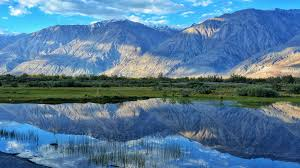-Shri Santi Ranjan Karar

SECMOL (Students Education and Cultural Movement of Ladakh) established in 1988 under the
leadership of Shri Sonam Wangchuk, emerged from the initiative of Ladakhi college students
who recognised the need for significant reforms in the education system. Over the years,
SECMOL has focused on reshaping the government school system while evolving its own
campus into an eco-village. This campus serves as a unique educational environment where
students, faculty, and volunteers coexist, engaging in practical, environmental, social, and
traditional learning experiences. The campus is, however, powered by solar energy, the
SECMOL Campus offers a blend of ancient Ladakhi cultural teachings with modern academic
knowledge. Here, students actively participate in managing and maintaining the campus,
learning not only academic subjects but also Ladakhi traditional songs, dances, and cultural
activities are the part of educational curriculum.
Ladakh is a cold desert in India. It lies in the Great Himalayas, on the eastern side of Jammu and
Kashmir. It has the mighty Karakoram Range in the North and in the south, it is bound by the
Zanskar mountains. Several rivers flow through Ladakh. The most important one is the Indus.
These rivers form deep valleys and gorges. They add to the scenic beauty of the place. Several
glaciers are found in Ladakh. The Gangotri glacier is an example. The altitude in Ladakh varies
from about 3000m in Kargil to more than 8000 m in the Karakoram.
Ladakh boasts a rich cultural heritage influenced by Tibet, India, and Central Asia. Despite its
historical isolation, recent years have witnessed rapid development and increased tourism.
SECMOL endeavours to empower young Ladakhis, particularly those from rural or
disadvantaged backgrounds, by providing them with the tools, insights, and confidence to
shape a sustainable future amidst these changes.
“Three Idiots” – In the film, his name (The Hero) was Phunsukh Wangdu. Indeed, everyone now
knows his true identity. This young man pursued mechanical engineering. Despite having a
successful father, he was not admitted to engineering based solely on his father’s name. He
wanted to be admitted based on his own merit. However, during his college years, his father
refused to provide financial support, as the son was determined to pursue civil engineering
instead. So, the young man started tutoring other students to earn his own way. After
completing his education, he began to assemble teaching mostly the dropout students.
Innovative and unique technique he adopted to start up the school “SECMOL,” which stands for
Student Education and Cultural Movement of Ladakh.
Yes, it’s a movement indeed! In an area where only 5% of students used to pass the 10th-grade
exams, now 75% pass. And one distinctive feature of that school was that only dropout students
could enrol there. What else can one say about such a movement? Once Shri Sonam Wangchuk
became a scientist, he focused on preserving the sensitive ecology and environment of the
region where he resided, promoting sustainable development. His scientific endeavours aimed
to address the challenges posed by the Himalayas lagging behind, scarcity of water for
agriculture, and the need for sustainable energy solutions. Indeed, his school solely relied on
solar power, with no other energy sources used. Even the water pipes were not powered by
electricity; they relied solely on gravitational force. The glacier is receding. There’s a crisis in
agriculture due to water scarcity. To mitigate this crisis, artificial glaciers, or ice stupas, have been
constructed. And even in these ice stupas, no electricity is used; only gravitational force is
utilised. The artificial glacier has grown significantly taller. It’s perhaps the first and only manmade
glacier in the world. From here, automatic water supply is facilitated for agriculture during
the warmer months. He also built “Warm Shelters for Soldiers” in Ladakh. These shelters provide
comfort to soldiers stationed in the harsh cold, without the need for air conditioning or
conventional energy sources. For this work, the government awarded him one crore rupees,
which he spent students welfare. He was also conferred Magsaysay Award in the year 2018.
He undertook many such initiatives, but above all, he was an environmentalist, climate
researcher, and educator.
When Article 370 was revoked from Jammu and Kashmir in 2019, Ladakh emerged as a
separate union territory. The people of Ladakh were delighted because Ladakh had never been
a priority for the central political parties in Kashmir. At that time, the Political Leaders and the
government promised them inclusion in the Sixth Schedule of the Indian Constitution. But that
promise has not been fulfilled; it has been swept aside in elections.
What exactly does the Sixth Schedule in the Constitution entail? In India, states with Scheduled
Tribes comprising 50% of the population are incorporated into this Schedule for safeguarding
their interests. With 97% of Ladakh’s population being from Scheduled Tribes, they seek
protection under this Schedule, as permitted by the Constitution. This is their demand: to secure
their rights. With this protection, they would have autonomy over their natural resources,
safeguarding them from corporate exploitation for profit. Development manifests differently in
various regions. It’s not just about erecting skyscrapers, malls, and industrialisation, as seen in
cities like Delhi, Bangalore, or Mumbai. True development integrates nature preservation,
embodying what we define as Sustainable Development.
The unique characteristics, culture, language, and dietary habits of the people of Ladakh—they
want to preserve all of them. Who wouldn’t want that? I believe we all want to live with our own
culture and language. India is a diverse country—“unity in diversity” That’s what we have learned
from our morning lessons. Those whose ancestors achieved the title of Bharat Ratna are now
leading protests without eating for 21 days. Those who run the country, if they turn a blind eye,
how can we? There’s a need for it, and we need to know that.
The majestic beauty of Ladakh’s natural landscapes, set amidst the rugged cold of the
Himalayas, including the awe-inspiring vistas of snow-covered terrain and expansive glaciers, is
a divine gift. It is imperative that we refrain from destroying or exploiting these natural wonders.
Any attempt to do so forcefully will not be pardoned by nature. Instances of man-made climate
change have been witnessed numerous times, with the recent 2022 incident of a moraine
glacier lake bursting in Sikkim serving as a poignant example. The catastrophic consequences of
such events, akin to natural disasters, are still fresh in the memories of people in North Bengal.
The impact of tourism businesses, controlled by corporations, on regions like Uttarakhand and
Himachal Pradesh (such as Joshimath), resulting in the degradation of mountains, communities,
and resources, leading to landslides and endangering lives, raises similar concerns for Ladakh.
Recent discoveries of rare minerals in Ladakh’s vast expanse have sparked corporate interest,
driven by profit motives, posing a significant threat to the region’s natural integrity. Additionally,
there’s a looming danger to the rivers of North India, whether through floods or droughts.
Hence, it is imperative for Ladakh to be granted protection under the Sixth Schedule,
empowering its inhabitants to safeguard their rights to land, water, and forests, thereby
preventing their exploitation by profit-driven corporations.
“Climate activist Sonam Wangchuk ended his 21-day hunger strike, as on Tuesday (26 March
2024) . Wangchuk launched “Climate Fast for 21 days (extendable till death) ” on March 6. While
ending his hunger strike on Tuesday, he said that it was not the end of the protest. “This is the
end of the first phase of the hunger strike.. It’s a new beginning. The new phase will start on
[Wednesday, March 27]. Women will hold hunger strike from tomorrow…this will go on. In a poston X, he reached out to Prime Minister Narendra Modi and Home Minister Amit Shah, “We need
statesmen of integrity, farsightedness & wisdom in this country and not just shortsighted
characterless politicians…and I very much hope that Narendra Modi ji and Amit Shah ji will soon
prove that they are statesmen…” He also tweeted on Tuesday reminding PM Modi and Amit
Shah of the promises they made to the people of Ladakh in the past two elections.
During his 21-day hunger strike, Wangchuk highlighted the pressing environmental challenges
facing our planet, particularly in the Himalayas and the Tibetan plateau, emphasising issues such
as global warming and climate change. He underscored the rapid melting of Himalayan glaciers
as a stark manifestation of these challenges. Additionally, Wangchuk advocated for Ladakh’s
statehood and its inclusion in the Sixth Schedule of the Constitution, which governs the
administration of tribal areas in Assam, Meghalaya, Tripura, and Mizoram through autonomous
district councils. Following the August 2019 decision to separate Ladakh from Jammu and
Kashmir and revoke Article 370, stripping the region of its statehood and semi-autonomy,
Wangchuk’s demands gained increased urgency.
Let’s delve into the specific demands of SECMOL:
1: Inclusion in the 6th Schedule of the Constitution.
2: Attainment of statehood for Ladakh. (Similar to Delhi) which is under Union Territory but
having its own Assembly, Chief Minister etc.
3: Recognition at least two representatives in the Parliament from Ladakh.
4: Establishment of a Public Service Commission for Ladakh.
A significant political imperative is at play here. Following the abrogation of Article 370 from the
Constitution in 2019, Jammu and Kashmir was declared as Union Territory, while Ladakh was
separated from Jammu and Kashmir to become its own Union Territory, effects from October 31,
2019.
The Bharatiya Janata Party (BJP) explicitly stated in their Election Manifesto of 2019, their
commitment to “Declaration of Ladakh under the 6th Schedule of the Indian Constitution”. The
aspirations and vision of the people of Ladakh from all walks of life have been taken into
account, including their primary demand for safeguards under the provisions of the 6th
Schedule.
While these demands may appear straightforward at first glance, it’s evident that their
complexities run deeper upon closer examination. It’s crucial to acknowledge the heightened
sensitivity of Ladakh’s geographical location in the current context. Furthermore, there’s the
looming threat of mobilising thousands of locals and nomads for a march to the China border,
aimed at raising global awareness about the ground reality. It’s imperative to assess the level of
support for such actions and the potential geopolitical ramifications.Considering the gravity of
the situation, it’s essential to contemplate the implications of both accepting and rejecting these
demands.
Furthermore, it is pertinent to analyse the influence of self-proclaimed global custodians in
shaping the narrative surrounding this geopolitical matter. It is crucial to scrutinise whether any
external interference is at play in the issue. In conclusion, I would like to caution that a looming
threat from the north demands our attention.
-Shri Santi Ranjan Karar
Introduction of the Author:
[A social activist devoted to serving humanity for nearly four decades. Honorary Guest Lecturerat De Montfort University, Leicester; University of Northampton; and Royal Holloway University
of London. Recipient of the UN Award for lifelong journey of social activism]








